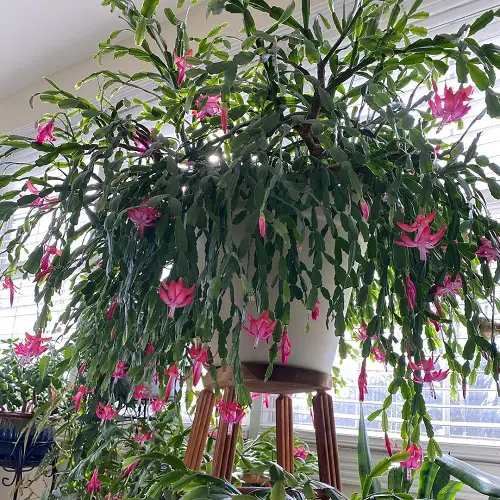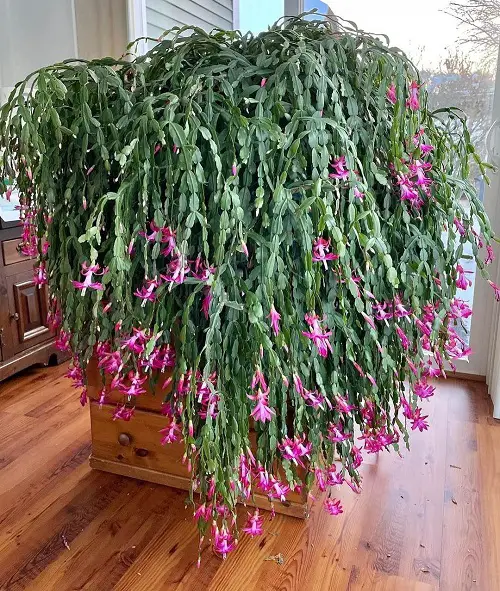Follow these Unusual Tricks to Grow a Big, Bold, and Blooming Christmas Cactus with expert tips on optimizing healthy growth.

Explore Unusual Tricks to Grow a Big, Bold, and Blooming Christmas Cactus and help this festive plant grow vigorously for your holiday decor.
7 Unusual Tricks to Grow a Big, Bold, and Blooming Christmas Cactus
Make It Bigger in Size

1. Sufficient CO2
Introduce a controlled release of carbon dioxide (CO2) near your Christmas Cactus.
Obtain a CO2 regulator and a CO2 cylinder. Make sure you also have a CO2 meter to monitor levels. Adjust your CO2 meter according to the instructions of the manufacturer.
Connect the CO2 cylinder to the regulator and then to a CO2 distribution system like a diffuser or a hose with holes. Seal the growing area to prevent CO2 leakage.
Adjust the CO2 regulator to maintain a concentration of 800-1500 ppm. Monitor with your CO2 meter. Operate the system during the daylight hours when the plant is photosynthesizing.
For best results, use CO2 enrichment during the vegetative growth stage.
Products You Can Use
- Titan Controls CO2 Regulator
- Autopilot APCEM2 Desktop CO2 Monitor
- Exhale Homegrown CO2 Bag
Science Behind It
Plants use CO2 for photosynthesis. In a typical home environment, they might not get as much CO2 as they could utilize for maximal growth. When you supplement with CO2, it can increase the rate of photosynthesis and potentially increase growth.
Supporting Researches
A study about the effects of CO2 enrichment on plant leaf ultrastructure found that elevated CO2 increased the number and size of starch grains in the chloroplast and leaf ultrastructure analysis.
A study by Oklahoma State University also states that, when you double the CO2 level setting (i.e., 700 to 800 parts per million) can significantly and visibly improve plant yield.
2. Hydroponic System
Instead of growing your Christmas Cactus in soil, consider using a hydroponic system, where the roots of the plant are suspended in a nutrient-rich water solution.
Science Behind It
Hydroponic systems provide constant access to water and nutrients, which directly leads to accelerated growth. This is because nutrient uptake is more efficient. It eliminates the energy the plant would usually spend searching for nutrients in the soil.
Make Christmas Cactus Bold

3. Color Spectrum Manipulation
LED lights that are programmable to different color spectrums can be used to influence various growth stages.
Buy a programmable LED grow light that allows you to adjust the color spectrum.
Use a blue-heavy spectrum (400-500 nm) during the vegetative stage to encourage bushy growth. Switch to a red-heavy spectrum (600-700 nm) during the flowering stage to encourage blooms.
Use the light for 12-16 hours per day, depending on the growth stage and specific needs of your Christmas Cactus.
Use blue light during the vegetative stage and red light during the flowering stage.
Products You Can Use
- Spider Farmer SF-1000 LED Grow Light
- VIPARSPECTRA Pro Series P1500 LED Grow Light
Science Behind It
Different wavelengths of light are known to affect plant growth in various ways. For instance, blue light generally promotes vegetative growth, while red light stimulates flowering.
When you control the light spectrum, you encourage specific types of growth at different times.
Supporting Researches
Research states that Photoperiod, light intensity, and light quality influence plant growth and development – from seed germination to flowering.
This study also highlights the importance of selecting the light wavelength that influences plant leaf, flower, and fruit production.
4. Use the Science of Photoperiodism for Flowering
The flowering of this plant is significantly influenced by photoperiodism, which is the biological response of an organism to changes in light duration. Do it for 6 weeks minimum till you see the formation of buds on the plant.
The Science Behind Light Manipulation
Christmas cacti are short-day plants, which means they require long periods of darkness to initiate flowering.
This is because, in their natural habitat, these plants bloom when the days are shorter and the nights are longer.
It is generally recommended that you start this in late September to early October. Continue it for at least six weeks or until buds appear for 12-14 hours of complete darkness per day.
It needs 10-12 hours of bright, indirect light.
How to Execute Light Restriction
Place the Christmas cactus in a room where it can be in total darkness for 12-14 hours. Alternatively, cover the plant with a dark cloth or place it in a dark box. Use a timer for both light and dark periods to regulate them accurately.
Expose the plant to the bright, indirect morning light for 3-4 hours.
Also, move the plant to a shaded area in the afternoon. Avoid hot, direct afternoon sun that can cause leaf scorching.
Science Behind It
During periods of darkness, the inactive form of phytochrome accumulates in the plant cells. When the plant is exposed to light, the phytochrome returns to its active form.
For short-day plants like the Christmas cactus, a specific point level of inactive phytochrome must be reached to initiate flowering.
This research talks about the workings of photoperiodism.
Making Christmas Cactus Bushier

5. Electrostimulation
In this process, you expose your Christmas Cactus to mild electrical currents.
For this, purchase a plant electrostimulator designed for horticultural use. Always wear rubber gloves to protect yourself from any electrical currents. Attach the electrodes to the base of the plant according to the instructions of the manufacturer.
Use low current settings initially (around 50-100 μA) and gradually increase based on plant response. Keep each electrostimulation session between 15 to 30 minutes.
Perform once a week initially and adjust based on the response of the plant.
It is best used during the vegetative growth stage to encourage bushiness.
Product You Can Purchase
ILSAGRO Plant Electrostimulation (specifically designed for agricultural and horticultural use)
Science Behind It
Electrostimulation is believed to encourage cell division and growth. It mimics the natural electrical signals of the plant for intracellular communication. The experimental technique has shown potential in enhancing nutrient absorption and overall growth in some crops.
Supporting Researches
This study by Frontiers proves that electrostimulation is an innovative and efficient way to increase plant growth.
A research paper also discusses the importance of it.
This research by the School of Life Sciences, Yunnan Normal University, China, also proves that electrical stimulation could boost seed germination, seedling growth, and plant thermotolerance improvement.
6. Sequential Pruning
Instead of the usual one-time pruning, how about you try a sequential pruning? In this, you have to prune a few stems over an extended period.
Get a pair of sharp, sterilized pruning shears to ensure clean cuts and reduce disease risk. Water the plant a day before pruning to ensure that it is well-hydrated. Start by pruning 5-8% of the oldest parts. Cut just above a segment joint.
Allow the plant an 8-10 days rest period to recover and redistribute the growth energy to the remaining stems.
After the rest period, prune another set of stems and focus on those that look weak or leggy. Avoid cutting parts that are near the sections that were pruned initially.
Continue this pattern every two weeks until you’ve pruned most of the stems you intended to cut back. Monitor the new growth and overall health of the plant, adjusting your technique as needed.
Sequential pruning can be done about a month after the plant stops flowering. This allows it to focus on new growth during the next active growth season.
Science Behind It
The idea behind sequential pruning is to allow the plant to redirect its energy toward fewer stems at a time. In a typical pruning scenario, the plant might be stressed by a sudden loss of a large portion of its growth, but sequential pruning minimizes this stress.
This allows the plant to focus its energy more effectively, which leads to a bushier growth pattern with thicker stems and potentially more blooms.
It reduces the risk of the diseases, as there are fewer open wounds at any time. This can result in a healthier, more robust plant over the long term.
Supporting Researches
A great study shows its importance.
Research by the Hunan Agricultural University, College of Horticulture, China, also states that light and heavy cutting could both obtain a larger number of flowers along with enhanced plant growth.
7. Propagating Cuttings in the Same Pot for Fullness
Propagating cuttings in the same pot efficiently achieves a fuller, bushier appearance for Christmas cactus!
Planting multiple cuttings in the same pot increases the number of growing points. More growing points lead to more branches and a fuller appearance. Multiple cuttings can cover the soil surface more quickly.
A faster-growing canopy keeps the soil moist, benefiting the overall health of the cactus.
How to Do It
Space the cuttings evenly to allow adequate room for growth and prevent overcrowding. For an exceptionally bushy look, consider clustering 3-4 cuttings together at different points in the pot.
Once the cuttings are established, strategic pruning can encourage even bushier growth.


